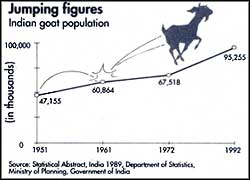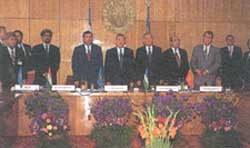Bush fires spread very fast
It is the turn of the Indian energy establishment to be engulfed in the fire lit by President George Bush on nuclear energy. Bush says it is the safest, cleanest, cheapest option. So prime minister
It is the turn of the Indian energy establishment to be engulfed in the fire lit by President George Bush on nuclear energy. Bush says it is the safest, cleanest, cheapest option. So prime minister
The World Bank, admitting the competition between food and fuel crops for land and water, has asked the national governments to carefully assess economic, environmental, and social benefits and the potential to enhance energy security. In its World Development Report-2008, it said: "The challenge for developing country governments is to avoid supporting bio-fuels through distortionary incentives that might displace alternative activities with higher returns - and to implement regulations and devise certification system to reduce environmental risks.' It suggested that the potential environmental risks from large scale bio-fuels production can be reduced through certification schemes for measuring environmentalaspects. It suggested a Green Bio-fuels Index of GHG reductions. The World Bank quoted that according to some available estimates, current bio-fuel polices the world over, can lead to a five-fold increase of the share of bio-fuels in global transport energy consumption - from 1% today to around 5% to 6% by 2020. "The grain required to fill the tank of a Sports utility vehicle with ethanol (240 kg of maize for 100 litre ethanol) could feed one person for a year, so competition between food and fuel is real,' the World Bank report said. It added that future bio-fuel technology may rely on dedicated energy crops and agricultural and timber wastes instead of food crops. "Technology to break cellulose into sugars distilled to produce ethanol or gasify biomass is not yet commercially viable - and will not be for several years. And some competition for land and water between dedicated energy crops and food crops will likely remain,' the report said. It further said that second generation bio-fuels using cellulosic technologies were likely to require even larger economies of scale, with investment costs in hundreds of millions of dollars just to build one plant. The report admitted that in industrial countries and till recently in Brazil, bio-fuel programmes were supported by high protective tariffs and large subsidies. These policies have caused land conversion away from food and led to an upward pressure on global food prices, severely affecting poor consumers. With a view to make bio-fuels compete with gasoline, industrial countries gave massive support and subsidies. According to recent estimates, more than 200 support measures costing around $5.5-7.3 billion a year in the US amount to $0.38-0.49 per litre of petroleum equivalent for ethanol and $0.45-0.57 for bio-diesel. In this context, the World Bank report questions - Are bio-fuels economically viable without subsidies and protection? It answers: "The breakeven price for a given bio-fuel to become economical is a function of several parameters. The most important determining factors are the cost of oil and the cost of the feedstock, which constitute more than half of today's production costs. Other often more cost-effective ways of delivering environmental and social benefits need to be considered, especially through improvements in fuel efficiency.
Mr. P.G. Jayachandran of Thrissur district in Kerala in his farm. Generating a better income from a limited area is an art, especially in farming operations, where judicious use of available space is an important factor. Very fewfarmers who practise integrated farming succeed in generating a good income from it. Managing successfully Mr. P.G. Jayachandran of Thrissur district in Kerala seems to be case in point. He has been successfully able to manage both crops and animal husbandry in his seven acre farm and integrate the different components into a single unit. He has a dairy unit of nine cows, with a daily milk production of about 60 litres. A part of the milk is sold to a milk society and the rest is used for making value added products such as buttermilk and ghee. Organic manures Fodder grass for the cattle is raised as an intercrop in his farm and coconut oil cake is used as feed for the animals. Organic manures such as cattle manure are the main source of nutrients for his crops. He also has a collection of Malabari, Jamnapari and Sannan goat breeds which are mainly used for kid production. A piggery unit comprising large White Yorkshire and Landrace breeds, is primarily used for utilisation of agricultural waste. The piggery unit provides him considerable income without much expenditure, according to Dr. Sabin George, Assistant Professor (Animal Husbandry), Krishi Vigyan Kendra (KVK), Thrissur. Back yard poultry with about 50 layer birds of Gramalakshmi and Rhode Island Red breeds yield about 40 eggs daily which are sold in the market. In addition, he also has turkey, quail and guinea fowl. Good demand He has about 200 coconut palms, yielding 150 nuts a year, a part of which is used for seed nut production for his own nursery. The remaining nuts are used for production of coconut oil which has a good demand at his farm itself. He earns aboutRs. 1lakh a year from coconuts alone, after meeting all the expenses. According to Dr. T.N. Jagadeesh Kumar, Associate Professor, KVK, Thrissur, the different enterprises in his farm are arranged systematically to encourage maximum utilization of land and resources and integration of various components. Plantation crops such as rubber, coconut, and arecanut occupy the prime area of the farm. Other crops such as vegetables, banana, pepper, cocoa, colocasia, elephant foot yam, and yams are intercropped, wherever feasible. The animal sheds are situated at the middle to facilitate transport of manures to all parts of the farm. Water harvesting Water harvesting devices (tanks lined with silpauline sheets) are located at an elevation which permits gravitational flow of water to all parts of the farm. Fish varieties such as Rohu, Catla, Grass carp and Mrigal are bred in a twenty-five cent pond in the farm, and the slurry used for irrigation. In addition, Mr. Jayachandran maintains a biogas plant and vermicompost unit for organic manure production. He raises azolla in shallow tanks for feeding poultry and cattle, which improve the quality of produce. Intercropping The coconut and arecanut gardens are intercropped with banana, colocasia and yams. He has a wide collection - about 15 types of banana. He considers banana as a maximum utility crop since all the plant parts are used - bunches harvested, suckers sold and the pseudostem used for mulching and vermicompost production. Banana cultivation, mostly intercropped, alone gives him an annual return of Rs.85,000. The farmer also has about 50 nutmeg trees, intercropped with garcinia, and coffee. Part of the garcinia and coffee is used for home consumption and the balance, marketed. He maintains a nursery in his farm where good quality seedlings of all the crop varieties grown and sold. Readers can contact Mr. P. G. Jayachandran, Puthuppally House, Kaniarkode Post, Pin 680 659 Thiruvilwamala Via, Thrissur 680 594 and Dr. T N. Jagadeesh Kumar, Associate Professor (Agronomy), mobile: 9447467288 and Dr. Sabin George, Assistant Professor (Animal Husbandry), K.V.K, Thrissur, Vellanikkara, KAU Post, pin 680 656, mobile: 9446203839.
<p><a href="http://en.wikipedia.org/wiki/Gopalkrishna_Gandhi">Gopalkrishna Gandhi</a>, the governor of West Bengal knows that we need to learn to walk the talk. He lives, as he says, in a 84,000 sq feet building – <a href="http://rajbhavankolkata.gov.in/">the majestic Raj Bhawan</a> (Governor’s residence) – in a massive 11 hectare plot of land in the heart of Kolkata city.
It was June of 1992. The location was Rio de Janeiro. The occasion was the world conference on environment and development. A large number of people had come out on the streets. They were protesting the
<p style="line-height: 22px; font-size: 14px; margin-top: 5px; color: rgb(0, 0, 0); font-family: Arial, Helvetica, sans-serif;"><em>Catalysing safe design for public spaces should be among the top priorities
<p><strong><img alt="" src="http://www.indiaenvironmentportal.org.in/media/iep/homepage/msanwal_blog.jpg" style="width: 600px; height: 117px;" /></strong></p> <p><strong>Small changes in urban human behavior

The ambitious Indian space programme, despite occasional setbacks, has had its share of success. A backgrounder to the programme which is very much in the news today

Are goats responsible for increasing desertification? No, say many environmentalists and researchers. In fact, this hardy animal fertilises degraded land efficiently, besides being a valuable source of income and nutrition for the poor

With lax regulations and a huge mercury loss unaccounted for, a disaster is waiting to happen in India

Modern practices are threatening to break up an unusual water tapping and water sharing process in Himachal Pradesh. Devised hundreds of years ago, it converted barren land in Spiti into fertile fields.

Are the new ISRO 14000 environment standards industry"s gift to a polluted globe, or merely the developed world"s competition killing strategy

Resource crunch and poor regulatory processes have made small-scale industries the pariahs of India"s environment

Overexploitation, skewed pricing policies and inefficient utilisation have laid bare the bamboo"s vast reserves. While local communities clamour for the resource, and possiblities of sustainable use abound, governments dole it out to industry. Arunachal,

Port Blair, port city of the Andamans, is in a developmental cul de sac

Once hailed as a boon to health, chlorine is now charged with being carcinogenic, maiming the immune and the reproductive systems.

"Forgive us, Aral. Please come back." These words written in chalk, on a ship sftKk in a sandy wasteland, which was once the bustling shore of the world"s fourth largest lake, the Aral Sea, tell a graphic tale of the human toll caused by am of the w

Is there a worldwide trend of sustained growth towards sustainable development?

Nepal's controversial Arun III dam becomes the first World Bank bankrolled project taken up for re scrutiny by the Bank's new Inspection Panel an ombudsman body with teeth

A recent workshop reveals that the rehabilitation of the 1993 Marathwada earthquake victims was a bloody farce